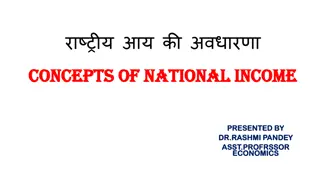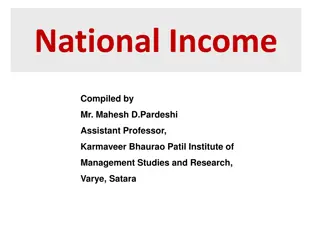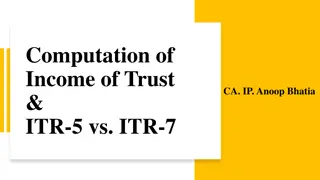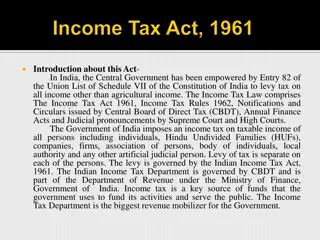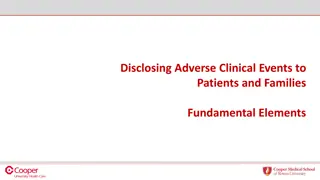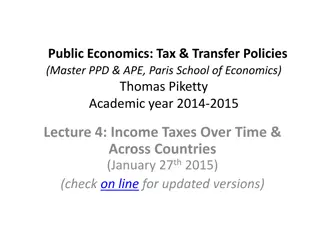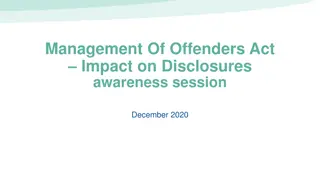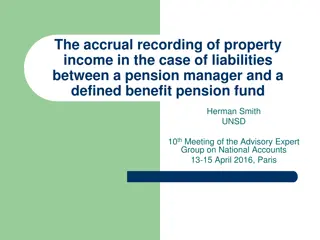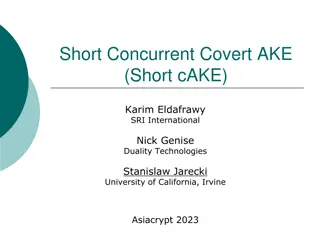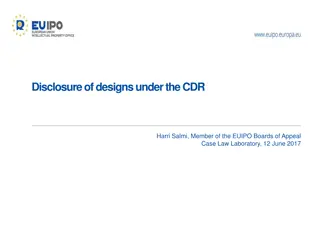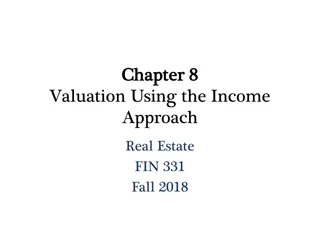Overview of Income Computation and Disclosure Standards (ICDS)
The Income-tax Act, 1961 introduced Income Computation and Disclosure Standards (ICDS) to be followed by certain assesses for computation of income. ICDS applies to taxpayers using the mercantile system of accounting from the Assessment Year 2016-17 onwards. Non-compliance with ICDS can lead to Best Judgment Assessment. The standards impact tax calculations, financial reporting, and may trigger assessments under Section 144.
Download Presentation

Please find below an Image/Link to download the presentation.
The content on the website is provided AS IS for your information and personal use only. It may not be sold, licensed, or shared on other websites without obtaining consent from the author.If you encounter any issues during the download, it is possible that the publisher has removed the file from their server.
You are allowed to download the files provided on this website for personal or commercial use, subject to the condition that they are used lawfully. All files are the property of their respective owners.
The content on the website is provided AS IS for your information and personal use only. It may not be sold, licensed, or shared on other websites without obtaining consent from the author.
E N D
Presentation Transcript
1 Income Computation and Disclosure Standards (ICDS) February 2016 Damania & Varaiya Chartered Accountants Devanshi Vakil Hetal Vakharia
2 Contents 1. General principles 2. ICDS II: Valuation of Inventories 3. ICDS IX: Borrowing Costs Damania & Varaiya
3 General principles Section 145(2) of the Income-tax Act, 1961 (Act) , the CG may notify in the Official Gazette from time to time, the Accounting Standards (w.e.f. AY 2014-15 ICDS) to be followed by any class of assessees or in respect of any class of income. Accordingly, CBDT has notified 10 Income Computation & Disclosure Standards (ICDS) vide their Notification S.No 892 (E) dated 31st March, 2015. Finance Act, 2014 amended section 145(2) of the Act to substitute accountingstandards with income computation and disclosure standards (ICDS). ICDS applies only to taxpayers following mercantile system of accounting. Damania & Varaiya
4 General principles ICDS are applicable for computation of income chargeable under the head profits and gains of business or profession and income from other sources only. Assessee s need not maintain Separate Books of Accounts for the purpose of ICDS These ICDS are applicable from the Assessment Year 2016-17 onwards. Damania & Varaiya
5 General principles Applicability for FY 2015-16 ICDS is applicable from financial 2015-16, which would make following impacts with immediate effect : Computation of advance tax for assessment year. Tax Expenses on quarterly results of the Company. Non Compliance Non Compliance with ICDS can be ground for an assessing officer to complete the Assessment under Best Judgment Assessment under Section 144. Damania & Varaiya
6 Title of ICDS with its Corresponding AS ICDS No ICDS Title Equivalent AS Issued by ICAI AS Title I Accounting Policies 1 Disclosure of Accounting Policies II Valuation of Inventories 2 Valuation of Inventories III Construction Contract 7 Construction Contracts IV Revenue Recognition 9 Revenue Recognition V Tangible Fixed Asset 10 Accounting for Fixed Assets VI Effects of Changes in foreign exchange rates 11 Effects of Changes in foreign exchange rates Damania & Varaiya
7 Title of ICDS with its Corresponding AS ICDS No ICDS Title Equivalent AS Issued by ICAI AS Title VII Government Grants 12 Accounting For Government Grants VIII Securities 13 Accounting for Investments IX Borrowing Costs 16 Borrowing Costs X Provisions, Contingent Liabilities and Contingent Assets 29 Provisions, Contingent Liabilities and Contingent Assets Damania & Varaiya
8 ICDS II Valuation of Inventories Damania & Varaiya
9 ICDS II Valuation of Inventories Scope of AS-2 & ICDS-II AS-2 shall apply for accounting of inventories other than: WIP under Construction contracts/WIP arising in the ordinary course of business of Service providers Shares , Debentures and other financial instruments held as stock in trade Producers Inventories of Live stock etc to the extent measured at NRV However as per ICDS-II, WIP other than those arising from Construction Contracts are dealt in other ICDS. Damania & Varaiya
10 ICDS II Valuation of Inventories Definition of Inventories as per ICDS-II and AS-2 Inventories are assets: held for sale in the ordinary course of business; in the process of production for such sale; or in the form of materials or supplies to be consumed in the production process or in the rendering of services. Net realisable value is the estimated selling price in the ordinary course of business less the estimated costs of completion and the estimated costs necessary to make the sale. Inventories should be valued at the lower of cost and net realisable value. Damania & Varaiya
11 ICDS II Valuation of Inventories Cost of Inventories Cost of Inventories as per AS-2 consists of : Cost of purchase Cost of Conversion Other costs However as per ICDS, Cost of Inventory shall also include Cost of Services. Damania & Varaiya
12 ICDS II Valuation of Inventories Cost Formulae for Cost of Purchase Cost formula as per AS-2: Cost of Purchase: Purchase price including taxes (Other than those that are subsequently recoverable) Less: Trade Discounts , Rebates, Duty Drawback and other similar items However ICDS does not exclude the items that are subsequently recoverable from purchase price. As per ICDS-II: Labour Cost Other Costs Cost of Services However AS-2 does not prescribe any method of valuation of Inventories in case of Services. Damania & Varaiya
13 ICDS II Valuation of Inventories Cost of Conversion Directly related costs to production of units Systematic allocation of Fixed Overheads Variable Production Overheads Damania & Varaiya
14 Other Costs 1. Other costs shall be included in the cost of inventories only to the extent that they incurred in bringing the inventories to their present location and condition. 2. Interest and other borrowing cost to be added if it meets the criteria of recognition as per relevant borrowing cost. ICDS II Valuation of Inventories are ICDS Damania & Varaiya
15 Practical Example : Q. Closing Inventory at cost of a company amounted to Rs. 9,56,700. The following items were included at cost in the total- (a) 350 Shirts, which had cost Rs.380 each and normally sold for Rs. 750 each. Owing to a defect in manufacture, they were all sold after the Balance Sheet date at 50% of their normal price. Selling expenses amounted to 5% of the proceeds. (b) 700 Trousers, which had cost Rs. 520 each. These too were found to be defective. Selling Expenses for the batch totaled Rs. 3800. They were sold for Rs. 950 each. Calculate the Inventory Value considering the above items. Damania & Varaiya
Solution: 16 (a) Valuation of Shirts: (i) Value of Stock at Cost (Rs. 380 x 350 units ) Rs. 1,33,000 (ii) NRV of Shirts ( Rs. 750 x 50% x 350 units) less 5% thereon Rs. (1,24,688) (iii) Write-down required for Shirts (i-ii) Rs. 8,312 (b) Valuation of Trousers: Cost of Trousers as given = Rs 520 x 700 Trousers = Rs. 3,64,000 Net Realizable Value of Trousers= Estimated Sale Price per unit Less: Selling Expenses per unit (Rs.3,800 / 700 Trousers) Rs. (5.43) Net Realizable Value per Unit Rs. 950.00 Rs. 944.57 Value= Lower of (i) Cost Rs. 520 & (ii) NRV Rs 944.57. Therefore, Rs.520 per unit or Rs. 3,64,000 should be the Carrying Amount of this Inventory. Since, Inventory is already carried at cost, no further adjustment is required. Damania & Varaiya
17 c) Valuation of Inventory Value of Inventory as given 9,56,700 Less: Write down of Value of Shirts (8,312) Revised Inventory Value 9,48,388 Damania & Varaiya
18 ICDS II Valuation of Inventories Exclusions from cost of inventories In determining the cost of inventories, the following costs shall be excluded and recognized as expenses of the period in which they are incurred: (a) Abnormal amounts of wasted materials, labour, or other production costs: (b) Storage costs, unless those costs are necessary in the production process prior to a further production stage: (c) Administrative overheads that do not contribute to bringing the inventories to their present location and condition ; (d) Selling costs. Damania & Varaiya
19 ICDS II Valuation of Inventories Valuation of opening inventories: Cost Scenario Continuing Business Preceding year s closing inventory Newly Commenced Business Cost of inventory acquired Acquisition of Running Business on slump sale basis Price paid Partner takeover running business of Firm/LLP Value considered in inter se settlement Conversion of Capital assets into stock in trade Fair value as on date of conversion [Section 45 (2) ] Damania & Varaiya
20 ICDS II Valuation of Inventories Method of Valuation of Inventories: First in First Out (FIFO) Weighted Average Retail Price Standard cost not Permitted by ICDS where as Permitted by AS Assessee following standard cost method is required to do the adjustment in accounting policy to adopt FIFO or Weighted Average method. Change in method Not permitted without reasonable cause Damania & Varaiya
21 In case of dissolution of a partnership firm or association of person or body of individuals, notwithstanding whether discontinued or not, the inventory on the date of dissolution shall be valued at the net realizable value. ICDS II Valuation of Inventories business is In Case of Dissolution This is unfair particularly as there is no specific provision for allowing such NRV as the cost to the successor of the business. Damania & Varaiya
22 A.L.A. Firm v. CIT [1991] 55 Taxman 497 (SC) / 189 ITR 285 ICDS II Valuation of Inventories In cases of dissolution of firm, the stock-in- trade will have to be valued at the prevailing market price while preparing the accounts if the business of the firm is discontinued. Case Laws Sakthi Trading Co. v. CIT [2001] 118 Taxman 301 (SC) / 250 ITR 871 If on dissolution of the firm the business is not discontinued, then, the ordinary principle of commercial accounting permitting valuation of stock-in-trade at Cost or Net Realizable value whichever is lower will apply. Damania & Varaiya
23 ICDS II Valuation of Inventories Transitional Provisions Interest and other borrowing costs, which do not meet the criteria for recognition of interest as a component of the cost, but included in the cost of the opening inventory as on the 1st day of April,2015, shall be taken into account for determining cost of such inventory for valuation as on the close of the previous year beginning on or after 1st day of April,2015 if such inventory continue to remain part of inventory as on the close of the previous year beginning on or after 1st day of April,2015. However, there is no such provision in Accounting Standard. Damania & Varaiya
24 ICDS II Valuation of Inventories Disclosure: (a) the accounting policies adopted in measuring inventories including the cost formulae used. (b) the total carrying amount of inventories and its classification appropriate to a person. Damania & Varaiya
25 ICDS II Valuation of Inventories Some Issues Unanswered: Inventory Valuation (Grossing up off refundable Taxes) Exclusive versus Inclusive method of accounting. Determination of WIP in case of consultancy/ professional service provider. This ICDS is whether attempting to define cost of services or cost of inventory in the Provision of Services. Generally, in case of Service sector, Percentage of Completion Method is adopted wherein, the revenue in respect of services rendered during a year is recognized in the same year. It is not clarified in the ICDS that whether the requirement will apply to value of services in respect of which revenue is already recognized. Damania & Varaiya
26 ICDS IX Borrowing Costs Damania & Varaiya
27 ICDS IX Borrowing Costs Definition of Borrowing Cost: Borrowing Cost as per AS-16 Finance charges in respect of Assets acquired under Finance Lease Amortization of Discounts or Premiums Exchange differences arising from Foreign Currency Borrowings Interest & Amortization of ancillary costs Commitment charges However ICDS does not recognize, Exchange differences arising from Foreign Currency Borrowings which are adjusted to Interest costs, as a component of Borrowing cost. Damania & Varaiya
28 ICDS IX Borrowing Costs Definition of Qualifying Asset: Qualifying Assets (QA) as per ICDS: Tangible assets Intangible assets Inventories that require more than 12 months to bring them to a saleable condition AS definition of qualifying asset refers to an asset that necessarily takes a substantial period of time to get ready for its intended use or sale (ordinarily 12 months) where as ICDS is silent on period of time except in case of inventories. Damania & Varaiya
29 Case study Qualifying assets for capitalization Facts A Specific Borrowing A is engaged in manufacturing business Bank It desires to replace its IT infrastructure at its Head office with new IT infrastructure system at total cost of $1 million Payment from Borrowed Funds A places order with vendor on 1st April 2015 and pays advance Vendor of Computers Vendor supplies and installs all the computers by 31 August 2015 (i.e. within five months) IT Infrastructure Acquisition & Installation completed in five months A pays balance amount to vendor on 31 August 2015 A has made specific borrowing from bank for the project. The payments to Vendors are made out of borrowed funds Damania & Varaiya
30 Case study Qualifying assets for capitalization Book Treatment as per ICAI AS-16 Tax Treatment pre ICDS PRE ICDS A can claim full deduction for interest u/s36(1)(iii) Arguably, interest not required to be capitalized in absence of extension to business IT infrastructure is not a qualifying asset (as it does not substantial period (> 1 Year as a benchmark to be ready for use). AS-16, therefore, does not require capitalization interest in present case take Tax Treatment post ICDS ICDS regards all fixed assets as qualifyingassets warranting capitalization of interest regardless of substantialperiod for being ready to use as a pre- condition ICDS will, therefore, require A to capitalise interest from the date of specific borrowing even if pending utilisation, the funds may have been kept in short term income yielding investment In view of amendment, A cannot argue that proviso/ICDS is not applicable in absence of extension to business Income earned from short term deployment of specific borrowed funds is to be offered to tax on gross basis rule) POST ICDS of Damania & Varaiya
31 ICDS IX Borrowing Costs Issues unanswered in ICDS regarding Definition of Qualifying Asset As per ICDS Definition, Land, Buildings, Machinery, Plant or Furniture, being Tangible Assets; Know-how, Patents, Trade-marks, Licenses, Franchises or any other business or commercial rights of similar nature, being Intangible assets; would be Qualifying Assets even if they take less than 12 months to become ready for intended use. Whereas as per AS-16, the basic condition for a Qualifying Asset is which necessarily takes a substantial period of time (ordinarily 12 months) to get ready for its intended use or sale. Damania & Varaiya
32 ICDS IX Borrowing Costs Recognition of Borrowing Cost Borrowing cost directly attributable for acquisition, construction or production of QA capitalized to cost of assets. The amount of Borrowing cost eligible for capitalization should be determined in accordance with this Income Computation & Disclosure Standard. As per ICDS, other Borrowing costs should be recognized in accordance with the provisions of the Act. However in AS, other borrowing costs should be expensed off in the period in which they are incurred. For the purpose of this ICDS, Capitalization in the context of Inventory means addition of Borrowing cost to the cost of Inventory. Damania & Varaiya
33 ICDS IX Borrowing Costs Borrowing cost eligible for Capitalization (Specific Borrowings) As per AS-16, Funds that are borrowed specifically for the purpose of obtaining a Qualifying Asset are to be capitalized in the following manner: Actual Borrowing Cost incurred Less: Any income on the Temporary Investment However as per ICDS, reducing income from Temporary Investments from the cost of borrowings is not prescribed. Damania & Varaiya
34 Issues unanswered in ICDS regarding Capitalization of Specific Borrowings As per Para 3 of ICDS (Specific Borrowings), Borrowing Costs directly attributable to the QA shall be capitalized as Cost of Asset. The amount of Borrowing costs eligible for capitalization shall be determined in accordance with this ICDS. Other Borrowing Costs shall be recognized in accordance with the Provisions of Income Tax Act, 1961. However Under the provisions of Income tax Act, 1961, Interest cost incurred by an Assessee is allowed as an expenditure but ICDS is silent on the same. Damania & Varaiya
35 ICDS IX Borrowing Costs Borrowing cost eligible for Capitalization (General Borrowings) As per AS-16, in case of General Borrowings, the amount of Borrowing costs eligible for Capitalization should be determined as follows: By applying a Capitalization rate to the expenditure of that asset. Capitalization rate should be the Weighted Average of the Borrowing Costs applicable to the Borrowings that are outstanding during the period, other than Specific Borrowings. However, the amount of Borrowing Costs capitalized should not exceed the amount of Borrowing costs incurred. Damania & Varaiya
PRACTICAL EXAMPLE: 36 The Borrowings Profile of A Ltd. Set up for the manufacture of antibiotics is as under: Date Description Amt Borrowed Purpose of Borrowings Incidental Exps 1st Jan 15% Demand Loan Rs. 60.00 Lakhs Acquisition of FA 8.33% 1st July 14.5% Term Loan Rs. 40.00 Lakhs Acquisition of P&M 5.00% 1st Oct 14% Bonds Rs. 50.00 Lakhs Acquisition of FA 8.00% The Incidental Expenses consist of Commission & Service charges for arranging the loans Fixed Assets considered as Qualifying Assets are as under: Sterile Manufacturing Shed- Rs. 10.00 Lakhs Plant & Machinery (Total)- Rs. 90.00 Lakhs Other Fixed Assets- Rs. 10.00 Lakhs The Project is completed on 31st December, and is ready for commercial production. Show the capitalization of Borrowing Costs. Damania & Varaiya
Solution: 1. Computation of Total Borrowing Cost (Rs. In Lakhs) 37 Loan Type Amt O/s Period Interest Incidental Cost Total Cost 15% Demand Loan 60.00 12 months 60*12/12*15%= 9.00 60*8.33% = 5.00 14.00 14.5% Term Loan 40.00 6 months 40*6/12*14.5%= 2.90 40*5% = 2.00 4.90 14% Bonds 50.00 3 months 50*3/12*14%= 1.75 50*8% = 4.00 5.75 Total 24.65 Note: Incidental Expenses are in the nature of Financing/Interest Cost, and is hence eligible for capitalization under AS-16 2. Computation of Capitalization Rate (i) Computation of Weighted Average General Borrowings Loan Type Date Amount Cumulative Amount Period O/s Product 1st Jan 15% Demand Loan 60.00 60.00 9 months 540.00 1st Oct 14% Bonds 50.00 110.00 3 months 330.00 Total 870.00 Damania & Varaiya
Weighted Average General Borrowings= 870 Lakhs/12 months= Rs. 72.50 Lakhs 38 (ii) Capitalization Rate= Borrowing Cost on General Borrowings = Rs. 24.65 Lakhs-4.90 Lakhs = 27.24% Weighted Average General Borrowings Rs 72.50 Lakhs 3. Computation of Borrowing Costs to be capitalized Asset Amount Spent Nature of Borrowing Borrowing Cost Total Borrowing Cost Specific General Specific General Sterile Mfg Shed Rs. 10.00L - Rs. 10.00L - 10L*27.24%= 2,72,400 2,72,400 P&M Rs. 90.00L Rs. 40.00L Rs. 50.00L Rs. 4.90L 50L*27.24%= 13,62,000 18,52,000 Other FA Rs. 10.00L - Rs. 10.00L - 10L*27.24%= 2,72,400 2,72,400 Borrowing Cost Capitalized 23,96,800 Damania & Varaiya
39 ICDS IX Borrowing Costs Borrowing cost eligible for Capitalization (General Borrowings) As per ICDS, General Borrowings are to be capitalized with the following formula: A x B Where, C A= General Borrowing Costs incurred (i) The average of costs of QA on the first & last day of the Balance Sheet of the PY. (ii) In case the QA does not appear in the BS on the First or both on the first & Last day of PY-Half the cost of QA B= (iii) In case the QA does not appear in the BS on the last day of PY, the average of Costs of QA as appearing in the BS on the First Day of the PY and on the Date of Completion. The average of the amounts of Assets funded by General Borrowings as on First & Last day of PY. C= Damania & Varaiya
40 PRACTICAL EXAMPLE: Description Amt Borrowed Purpose of Borrowings 15% Demand Loan Rs. 60.00 Lakhs Acquisition of FA 14% Bonds Rs. 50.00 Lakhs Acquisition of FA The cost of fixed Assets considered as Qualifying Assets as on 1st April, 2015 are as under: Sterile Manufacturing Shed- Rs. 10.00 Lakhs Plant & Machinery - Rs. 90.00 Lakhs Other Fixed Assets- Rs. 10.00 Lakhs The cost of fixed Assets considered as Qualifying Assets as on 31st March, 2016 are as under: Sterile Manufacturing Shed- Rs. 15.00 Lakhs Plant & Machinery - Rs. 100.00 Lakhs Other Fixed Assets- Rs. 20.00 Lakhs Total assets as per Balance Sheet as on 1st April, 2015 and 31st March, 2016 are 200.00 Lakhs & 300.00 Lakhs respectively. Show the capitalization of Borrowing Costs. Damania & Varaiya
Solution: (1) Computation of Total Borrowing Costs: 41 Loan Type Amt Interest 15% Demand Loan 60.00 60*15%= 9.00 14.5% Term Loan 40.00 40*14.5%= 5.80 14% Bonds 50.00 50*14%= 7 Total 21.80 Out of which General Borrowing Cost= 9+7= 16 (A) (2) Average of Costs of QA on 1st April, 2015 & 31st March, 2016= (10+90+10)+(15+100+20)/2 (3) Average of Costs of Total Assets as on 1st April, 2015 & 31st March, 2016= 200+300/2 =177.50 (B) = 110+135/2 = 250 (C) Therefore Interest to be capitalized with the following formulae: =A*B/C =16.00*177.50/250 =11.36 Damania & Varaiya
42 ICDS IX Borrowing Costs Commencement of Capitalisation As per ICDS- IX 1. Funds borrowed specifically for the purpose of acquisition of QA As per AS- 16 Capitalisation of borrowing costs should commence when conditions are satisfied: all the following Date on which funds borrowed. 1. Expenditure on the asset has been incurred, 2. Funds borrowed generally and utilized for the purpose of acquisition of a qualifying asset 2. Borrowing costs are being incurred, 3. Activities that are necessary to prepare the asset for its intended use or sale are in progress. Date on which funds were utilized. Damania & Varaiya
43 Group Companies Facts Financial Institution B is engaged in manufacturing business Term loan B sets up new unit for manufacturing Unsecured Loan B unit admittedly represents extension of business Cash Credit The investment in new unit is financed from B Bank o Specific term loans from financial institutions for plant and machinery o Cash credit facility for working capital; o Unsecured loans from group companies Qualifying asset (New unit) The new unit is treated as qualifying asset under AS-16 and borrowing cost is captalised in books as per capitalization norms provided under AS-16. Damania & Varaiya
44 ICAI AS-16 ICDS Particular Specific Borrowing General Borrowing Specific Borrowing General Borrowing Commencement date of capitalization Fulfillment of all three conditions viz. incurrence of capex, incurrence of borrowing costs and construction activity is in progress From date of borrowing once borrowing is for fixed asset Date of utilization of borrowed funds Pro-rata borrowing cost allocation as per normative formula (Refer illustration in subsequent slides) Capitalization triggered w.r.t. 50% cost irrespective of whether the asset remains under construction for 1 or 364 days Method of Capitalization Borrowing directly attributable to qualifying asset from date of fund deployment to date of asset being ready for use costs Weighted cost applied to capex from date of capex to date of asset being ready for use average borrowing Borrowing costs from date of borrowing till date of asset first put to use (Proviso to s.36(1)(iii) of Suspension of capitalization if unexpected interruption in project? Yes No Damania & Varaiya
45 ICDS IX Borrowing Costs Cessation and Suspension of Capitalisation As per ICDS, till the QA is put to use or all the activities necessary to prepare such an inventory for its intended sale are complete capitalization shall be continued. On the other hand AS prescribes capitalization up to substantial completion of activities. Cessation Concept of suspension of capitalization in case of interruption in development is provided in AS . However, ICDS is silent on this matter. Suspension Damania & Varaiya
46 All the borrowing costs incurred on or after 1st day of April, 2015 shall be capitalized for the previous year commencing on or after 1st day of April, 2015 on accordance with the provisions of the standards after taking into account the amount of borrowing costs capitalized, if any, for the same borrowing for any previous year ending on or before 31st March, 2015. ICDS IX Borrowing Costs Transitional Provisions However, there is no such provision in Accounting Standard. Damania & Varaiya
47 ICDS IX Borrowing Costs Disclosure (a) The accounting policy adopted for borrowing costs. (b) The amount of borrowing costs capitalised during the period. Damania & Varaiya
48 Damania & Varaiya
49 Damania & Varaiya


